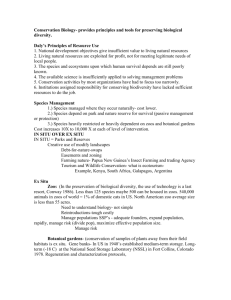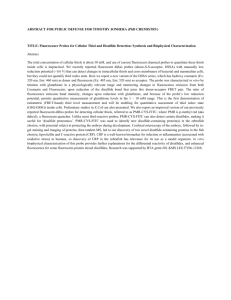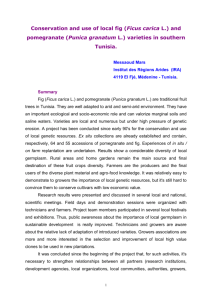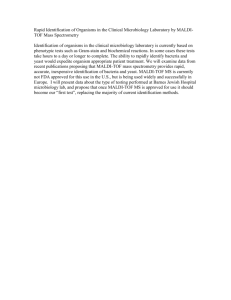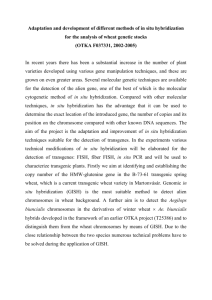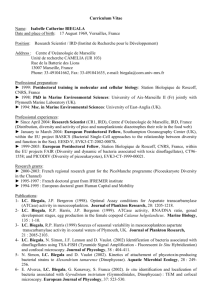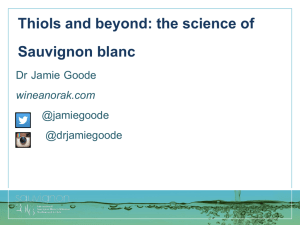- The University of Liverpool Repository
advertisement
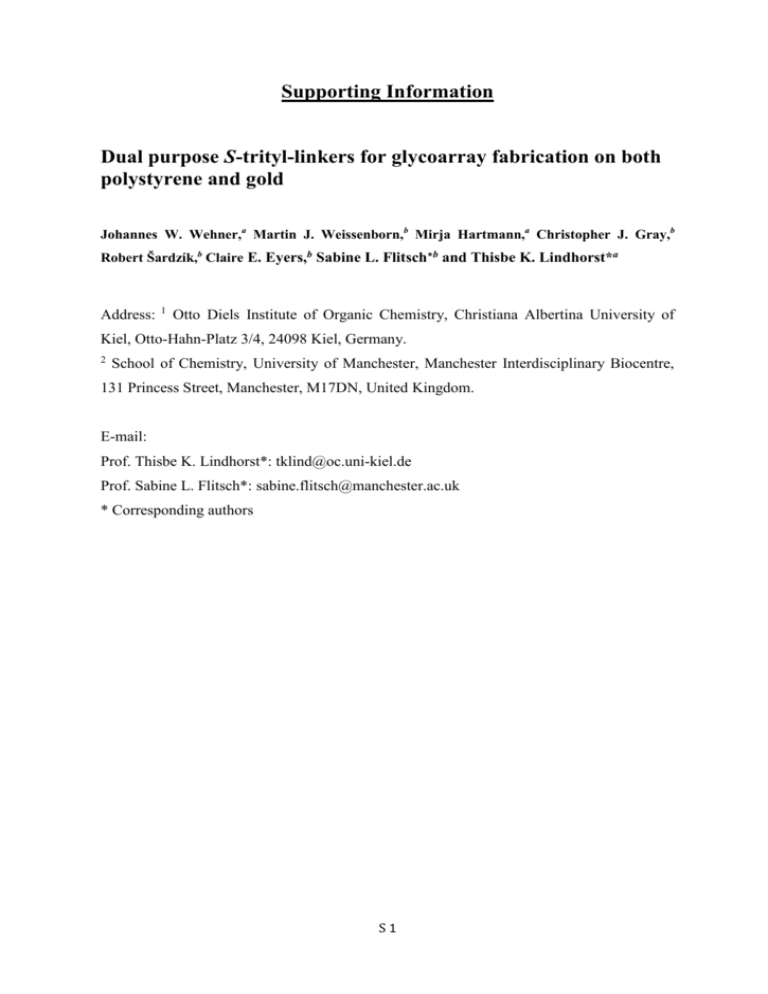
Supporting Information Dual purpose S-trityl-linkers for glycoarray fabrication on both polystyrene and gold Johannes W. Wehner,a Martin J. Weissenborn,b Mirja Hartmann,a Christopher J. Gray,b Robert Šardzík,b Claire E. Eyers,b Sabine L. Flitsch*b and Thisbe K. Lindhorst*a Address: 1 Otto Diels Institute of Organic Chemistry, Christiana Albertina University of Kiel, Otto-Hahn-Platz 3/4, 24098 Kiel, Germany. 2 School of Chemistry, University of Manchester, Manchester Interdisciplinary Biocentre, 131 Princess Street, Manchester, M17DN, United Kingdom. E-mail: Prof. Thisbe K. Lindhorst*: tklind@oc.uni-kiel.de Prof. Sabine L. Flitsch*: sabine.flitsch@manchester.ac.uk * Corresponding authors S1 Table of contents page Analytical data of tested compounds 1 1.1 N-(Acetyl)-S-(triphenylmethyl)-L-cysteine-[2-(-D-mannopyranosyloxy) ethyl]amide (5) S3 1.2 2-(11-Tritylsulphanyl-undecanoyl)aminoethyl -D-mannopyranoside (6) S5 1.3 N-(Acetyl)-S-(triphenylmethyl)-L-cysteine-[6-(-D-mannopyranosyloxy)-3thiahexyl]amide (10) S7 1.4 6-(10-Tritylsulphanyl-undecanoyl)amino-4-thiahexyl -D-mannopyranoside (11) S9 1.5 In situ S-detritylation of compounds 5, 6, 10 and 11 S10 1.6 2-(11-Sulphhydryl-undecanoyl)aminoethyl -D-mannopyranoside (6-SH) S11 2 2.1 Glycoarrays on gold S12 Gold chip functionalisation S12 2.1.1 Coupling of in situ deprotected thiols to unmodified gold surface 2.1.2 Coupling of in situ deprotected thiols to maleimide-terminated gold surface 2.2 3 S12 S12 MALDI-ToF MS analysis of SAMs on gold S12 2.2.1 SAM formation on gold surface using in situ deprotected thiols S13 2.2.2 SAM formation using maleimide-terminated thiols SAMs S16 2.2.3 Thiol coupling to maleimide-terminated SAMs S18 Glycoarrays on polystyrene S22 3.1 Material, media and buffer solutions S22 3.2 Blocking studies S22 3.3 Solvent studies S24 3.4 Binding studies S25 3.5 Comparison of bacterial adhesion to glycoarrays made with S-tritylated 3.6 4 S3 cysteinyl mannosides 5 and 10 S27 Phenol-sulphuric acid assay S28 References S28 S2 1. Analytical data of tested compounds Analytical HPLC was performed on a Merck Hitachi LaChrom L-7000 series apparatus with a LiChrospher 100 RP-8 (5 m, Merck) column. 1H and 13 C NMR spectra were recorded using a Bruker DRX-500 or a Bruker AV-600 spectrometer. NMR spectra were calibrated with respect to the solvent peak (in case of CDCl3 the reference was tetramethylsilane (TMS)). 2D NMR techniques (COSY, HSQC, HMBC) were used for full assignment of the spectra. 1.1 N-(Acetyl)-S-(triphenylmethyl)-L-cysteine-[2-(-D-mannopyranosyloxy)ethyl]amide (5) Synthesis and analytical data were in accordance with the literature.[1] OH OH O HO HO O 5 O N H NHAc S HPLC tR = 2.59 min (A = water, B = methanol, A: 20 %, 10 min, 1.2 mL/min); Figure S1: HPLC chromatogram of compound 5 (integrated chromatogram 240-271 nm). S3 Figure S2: 1H NMR spectrum (600 MHz, CD3OD) of compound 5. Figure S3: 13C NMR spectrum (150 MHz, CD3OD) of compound 5. S4 1.2 2-(11-Tritylsulphanyl-undecanoyl)aminoethyl -D-mannopyranoside (6) Synthesis and analytical data were in accordance with the literature.[2] HO HO OH OH O O 6 O S N H HPLC tR = 5.49 min (A = water, B = methanol, A: 20 %, 10 min, 1.2 mL/min); Figure S4: HPLC chromatogram of compound 6 (integrated chromatogram 240-271 nm). S5 Figure S5: 1H NMR spectrum (500 MHz, CD3OD) of compound 6. Figure S6: 13C NMR spectrum (125 MHz, CD3OD) of compound 6. S6 1.3 N-(Acetyl)-S-(triphenylmethyl)-L-cysteine-[6-(-D-mannopyranosyloxy)-3thiahexyl]amide (10) OH OH O HO O HO 10 O S N H NHR' S HPLC tR = 2.64 min (A = water, B = methanol, A: 20 %, 10 min, 1.2 mL/min); Figure S7: HPLC chromatogram of compound 10 (integrated chromatogram 240-271 nm). S7 Figure S8: 1H NMR spectrum (600 MHz, CD3OD) of compound 10. Figure S9: 13C NMR spectrum (150 MHz, CD3OD) of compound 10. S8 1.4 6-(10-Tritylsulphanyl-undecanoyl)amino-4-thiahexyl -D-mannopyranoside (11) OH OH O HO HO O 11 O S S N H HPLC tR = 6.11 min (A = water, B = methanol, A: 20 %, 10 min, 1.2 mL/min); Figure S10: HPLC chromatogram of compound 11 (integrated chromatogram 240-271 nm). Figure S11: 1H NMR spectrum (500 MHz, CD3OD) of compound 11. Figure S12: 13C NMR spectrum (125 MHz, CD3OD) of compound 11. S9 1.5 In situ S-detritylation[3] of compounds 5, 6, 10 and 11 S-tritylated mannosides 5, 6, 10 and 11 were de-tritylated, as described in the main manuscript for preparation of 6-SH, to give the respective thiols. The latter were used for fabrication of glycoarrays on gold without purification (Scheme S1). Scheme S1: In situ deprotection of S-tritylated mannosides 5, 6, 10 and 11 gave the respective thiols (5-SH, 6-SH, 10-SH and 11-SH) which were applied for the functionalisation of two different types of gold wafers: (a) plain gold and (b) maleimide-terminal SAMs on gold (in a linker to spacer ratio of 1:4). S 10 1.6 2-(11-Sulphhydryl-undecanoyl)aminoethyl -D-mannopyranoside (6-SH) HO HO OH OH O O 6-SH O SH N H Figure S13: 1H NMR spectrum (500 MHz, CD3OD) of compound 6-SH. Figure S14: 13C NMR spectrum (125 MHz, CD3OD) of compound 6-SH. S 11 2 Glycoarrays on gold 2.1 Gold chip functionalisation 2.1.1 Coupling of in situ deprotected thiols to unmodified gold surface Thiols were directly applied to the cleaned gold chip in PBS buffer (10 mM) and left for 1.5-12 h. Afterwards, the plate was thoroughly washed with ethanol, water and dichloromethane. 2.1.2 Coupling of in situ deprotected thiols to maleimide-terminated gold surface The respective thiol solution (10 mM in 10 mM PBS, 1 L) was applied spotwise to the maleimidefunctionalised SAMs, left for 1-3 h and analysed by MALDI-ToF MS. 2.2 MALDI-ToF MS analysis of SAMs on gold All spectra were analysed with FlexAnalysis software (Bruker, USA) using default integration settings. Calibration was either performed before the analysis at the Ultraflex II instrument or afterwards in FlexAnalysis. Unless otherwise noted, all m/z values refer to the [M+Na]+ ion and the corresponding disulphide which is formed during ionisation. S 12 2.2.1 SAM formation on gold surface using in situ deprotected thiols Figure S15: MALDI-ToF mass spectrum of gold surface modified with the purified thiol mannoside 6-SH. The respective disulphide (m/z 866.940 [M+Na]+ and m/z 882.913 [M+K]+) was detected. Figure S16: MALDI-ToF mass spectrum of gold surface modified with in situ deprotected mannoside 6-SH. The obtained spectrum is in analogy to the result obtained with the purified 6-SH. The respective disulphide (m/z 866.989 [M+Na]+ and m/z 882.970 [M+K]+) was detected. S 13 Figure S17: MALDI-ToF mass spectrum of gold surface modified with in situ deprotected mannoside 5-SH. The respective disulphide (m/z 756.941 [M+Na]+) was detected. S 14 Figure S18: MALDI-ToF mass spectrum of gold surface modified with in situ deprotected mannoside 11-SH. The respective disulphide (m/z 1015.040 [M+Na]+ and m/z 1031.022 [M+K]+) was detected. Figure S19: MALDI-ToF mass spectrum of gold surface modified with in situ deprotected mannoside 10-SH. Thiol 10-SH (m/z 464.746 [M+Na]+ and m/z 480.732 [M+K]+) and the respective disulphide (m/z 904.996 [M+Na]+) were detected. S 15 2.2.2 SAM formation using maleimide-terminated thiols SAMs A B Figure S20: MALDI-ToF mass spectrum of gold surface modified with hydroxyl- and carboxyterminal thiols. Analysis of the formed SAM on gold showed: A the mixed disulphide formed in situ from the hydroxyl- and carboxyl-terminal thiols (m/z 1051.220) and B the disulphide formed in situ from the carboxyl-terminal spacer (m/z 1241.240). S 16 B A Figure S21: MALDI-ToF mass spectrum of gold surface modified with hydroxyl- and carboxyterminal thiols (cf. Figure S20) after coupling of N-(2-aminoethyl)maleimide (Mal). Analysis of the formed SAM on gold showed: A the mixed disulphide formed in situ from the hydroxyl- and carboxyl-terminal thiols (m/z 1051.205) and B the mixed disulphide formed in situ from the maleimide and the hydroxyl-terminal molecules (m/z 1173.214). S 17 2.2.3 Thiol coupling to maleimide-terminated SAMs C B A Figure S22: MALDI-ToF mass spectrum of gold surface modified with N-(2-aminoethyl)maleimide (Mal) (cf. Figure S21) after coupling of purified thiol 6-SH (positive control). Analysis of the formed SAM on gold showed: A the mixed disulphide formed in situ from the hydroxyl- and carboxyl-terminal thiols (m/z 1051), B the thiol 6-SH coupled to the maleimide (m/z 1178.127) and C the mixed disulphide formed in situ from the hydroxyl-terminal linker and thiol 6-SH coupled to the maleimide (m/z 1596.332). A B Figure S23: MALDI-ToF mass spectrum of gold surface modified with N-(2-aminoethyl)maleimide (Mal) (cf. Figure S21) after coupling of Man-Trt 6 (negative control). Analysis of the formed SAM on gold showed no coupling of 6 and therefore only starting material was observed (cf. Figure S21). S 18 C A B Figure S24: MALDI-ToF mass spectrum of gold surface modified with N-(2-aminoethyl)maleimide (Mal) (cf. Figure S21) after coupling of in situ deprotected thiol 6-SH. Analysis of the formed SAM on gold showed: A the mixed disulphide formed in situ from the hydroxyl- and carboxyl-terminal thiols (m/z 1051.545), B the thiol 6-SH coupled to the maleimide (m/z 1178) and C the mixed disulphide formed in situ from the hydroxyl-terminal linker and thiol 6-SH coupled to the maleimide (m/z 1596.470). S 19 A C B Figure S25: MALDI-ToF mass spectrum of gold surface modified with N-(2-aminoethyl)maleimide (Mal) (cf. Figure S21) after coupling of in situ deprotected thiol 5-SH. Analysis of the formed SAM on gold showed: A the mixed disulphide formed in situ from the hydroxyl- and carboxyl-terminal thiols (m/z 1051.336), B the mixed disulphide formed in situ from the maleimide and the hydroxylterminal molecules (m/z 1173.350) and C the mixed disulphide formed in situ from the hydroxylterminal linker and thiol 5-SH coupled to the maleimide (m/z 1541.416). S 20 A C B Figure S26: MALDI-ToF mass spectrum of gold surface modified with N-(2-aminoethyl)maleimide (Mal) (cf. Figure S21) after coupling of in situ deprotected thiol 11-SH. Analysis of the formed SAM on gold showed: A the mixed disulphide formed in situ from the hydroxyl- and carboxylterminal thiols (m/z 1051.534), B the mixed disulphide formed in situ from the maleimide and the hydroxyl-terminal molecules (m/z 1173.586) and C the mixed disulphide formed in situ from the hydroxyl-terminal linker and thiol 11-SH coupled to the maleimide (m/z 1670.823). A C B Figure S27: MALDI-ToF mass spectrum of gold surface modified with N-(2-aminoethyl)maleimide (Mal) (cf. Figure S21) after coupling of in situ deprotected thiol 10-SH. Analysis of the formed SAM on gold showed: A the mixed disulphide formed in situ from the hydroxyl- and carboxylterminal thiols (m/z 1051.401), B the thiol 10-SH coupled to the maleimide (m/z 1197) and C the mixed disulphide formed in situ from the hydroxyl-terminal linker and thiol 10-SH coupled to the maleimide (m/z 1615.521). S 21 3 Glycoarrays on polystyrene 3.1 Material, media and buffer solutions Microtiter plates (96 wells) with a hydrophobic surface (Corning, no. 3631, 96 wells, flat clear bottom, black polystyrene, non-treated); Microtiter plates (384 wells) with a hydrophobic surface (Corning, no. 3540, low volume, 384 wells, flat clear bottom, black polystyrene, non-treated); LB-medium (+AMP, +CAM) (PKL1162): tryptone (10.0 g), sodium chloride (10.0 g), and yeast extract (5.00 g) were dissolved in bidest. water (1.00 L, pH adjusted to 7.0); after sterilization (20 min 120°C) and cooling to 60°C, ampicillin (100 mg) and chloramphenicol (50.0 mg) were added; PBS buffer solution (pH 7.2): sodium chloride (8.00 g), potassium chloride (200 mg), sodium hydrogen phosphate-dihydrate (1.44 g), and potassium dihydrogen phosphate (200 mg) were dissolved in bidest. water (1.00 L); PBST buffer solution (pH 7.2): PBS buffer + 0.05 % v/v Tween® 20; pH-Values were adjusted using 0.1 M HCl or 0.1 M NaOH, respectively. 3.2 Blocking studies Blocking agents are usually applied in microtiter plate assays to prevent unspecific binding to the hydrophobic polystyrene wells. Here, several blocking agents (BSA, gelatine and skimmed milk powder) were tested at different concentrations and incubation times. From all studies it could be seen that blocking had no influence on bacterial adhesion (Figure S28). Therefore, for all subsequent assays made in this study, no blocking agent was applied. Procedure: Solutions of BSA (1%, 5%, 10%), gelatine (1%, 5%, 10%) and skimmed milk powder (1%, 5%, 10%) in PBS buffer (pH 7.2) were prepared. Each solution was pipetted into a 96 well hydrophobic microtiter plate (Corning, no. 3631, 150 L/well) and incubated for 45 min and 2 h, respectively. Then, the plates were washed with PBST buffer (150 L/well). E. coli (PKL1162, 1 mg/mL in PBS buffer) were pipetted into the wells (100 L/well) and it was incubated for 45 min S 22 and 2h (37°C, 120 rpm), respectively. After subsequent washing steps with PBS buffer (3 x 150 L/well) and addition of PBS buffer (100 L/well) fluorescence was read out. Figure S28: Blocking agents and incubation times were varied to test the importance of blocking in cellular adhesion (here: E. coli PKL1162 cells) to the hydrophobic polystyrene wells used. The red line indicates the blank value of unblocked plates incubated with E. coli. This testing proved that blocking is not required to suppress unspecific adhesion in this case. S 23 3.3 Solvent studies Three solvents and solvent mixtures, respectively, were tested for immobilisation of the S-tritylated mannoside 6 on hydrophobic 384 well microtiter plates. As shown in Figure S29, methanol proved to be the most suitable solvent for this purpose. Procedure: Compound 6 was dissolved in MeOH, DMSO or DMSO/H2O (8:5) (25, 50, 100, and 200 mM), respectively. The solutions were added to a 384 well microtiter plate (Corning, no. 3540) (10 L/well) at four different concentrations (cf. Figure S29) and incubated overnight at ambient temperature. Then remaining solvents were removed and it was washed with H2O bidest. (3 x 20 L/well) and with PBST buffer (3 x 20 L/well). E. coli suspension (PKL1162, 1 mg/mL in PBS buffer) was pipetted into the wells (10 L/well) and it was incubated for 60 min (37°C, 120 rpm). After subsequent washing steps with PBS buffer (3 x 20 L/well) and addition of PBS buffer (10 L/well) fluorescence was read out. Figure S29: Three different solvents were used for immobilisation of the S-tritylated mannoside 6 at four different concentrations (25, 50, 100, and 200 mM). Fluorescent E. coli were allowed to adhere to the so formed surface and fluorescence was read out. Methanol was optimal at all tested concentrations. S 24 3.4 Binding studies Polystyrene surfaces were functionalised by non-covalent immobilisation of the polysaccharide mannan on one hand,[4] and on the other hand with the S-tritylated mannoside 6 and the S-tritylated non-glycosylated compound 3 as a control. Bacterial adhesion to these surfaces was tested using E. coli PKL1162. The results of this study are shown in Figure S30. Mannan coating: 96 well microtiter plate (Corning, no. 3631) were filled with a solution of mannan from Saccharomyces cerevisiae (1.2 mg/mL in carbonate buffer, pH 9.5; 100 μL solution per well) and allowed to dry in at 37 °C overnight. The plates were washed with PBST (3 x 150 μL/well). Before use the wells were blocked with BSA (5 % in PBS, 120 μL/well) for 2 h at 37 °C and then washed with PBST (3 x 150 μL/well). (Assay was performed as described in chapter 3.3) Immobilisation of 3 and 6: Solutions of 3 and 6 (50 mM & 200 mM in MeOH) were added to a 96 well microtiter plate (35 L/well) and incubated overnight at room temperature. Plates were washed with H2O (3 x 250 L/well). BSA blocking: A solution of BSA (3 %, 150 L/well) was added to the respective wells, followed by incubation for 45 min (37°C, 120 rpm). (Blocking was not necessary when S-tritylated mannosides were employed.) Bacterial adhesion assay: After washing the surface with PBST buffer (3 x 150 L/well), E. coli suspension (PKL1162, 1 mg/mL in PBS buffer) was pipetted into the wells (100 L/well) and it was incubated for 45 min (37°C, 120 rpm), followed by three washing steps with PBS buffer (150 L/well). For fluorescence readout (485/535 nm), PBS buffer was added to the wells (100 L/well). S 25 Figure S30: Fluorescence read out of bacterial adhesion (E. coli PKL1162) to variously treated polystyrene surfaces (hydrophobic microtitre plate). Blank: background signal, plain polystyrene, washed with H2O bidest. and PBST (3 x); mannan: mannan-coated surface; 3 and 6 were employed at two different concentrations (left: 200 mM; right: 50 mM of 3 and 6). Mannan-coated and uncoated (blank) surfaces show no significant difference in fluorescence intensity. This finding shows that mannan-coating is not suitable for testing mannose-specific bacterial adhesion on the employed hydrophobic polystyrene plates. Plates with immobilised mannoside 6, on the other hand, gave a good fluorescence signal. Bacterial adhesion to the control surface with immobilised 3 led to decreased fluorescence signal. By that we could show that the adhesion of E. coli PKL1162 is carbohydrate-specific. S 26 3.5 Comparison of bacterial adhesion to glycoarrays made with S-tritylated cysteinyl mannosides 5 and 10 For concentration-dependent tests on bacterial adhesion, hydrophobic 384 well microtiter plates for increased throughput and decreased material usage were applied. As expected, bacterial adhesion increases with increasing concentrations of mannoside solutions used for functionalisation of the polystyrene plate. However, when concentrations over 20 mM were employed, fluorescence signal was scattered (Figure S31). Thus, compounds 5 and 10 appeared less suited in this assay and were not used in further adhesion-inhibition studies with E. coli PKL1162. Figure S31: Results of bacterial adhesion (E. coli PKL1162) to glycoarrays obtained from differently concentrated solutions of S-tritylated mannosides 5 (left) and 10 (right) after 1 h incubation. Bacterial adhesion was measured by fluorescence read out. S 27 3.6 Phenol-sulphuric acid assay In order to determine the stability of glycoarrays formed from compounds 5, 6, 10 or 11 against different washing procedures a phenol-sulphuric acid assay was performed. Results are shown in Table S1. Table S1: Quantification of non-covalently immobilised S-tritylated mannosides 5, 6, 10, and 11 on polystyrene using phenol-sulphuric acid assay.* Concentration of mannoside 50 mM Glycoside quantity (%)** 25 mM Glycoside quantity (%)** 12.5 mM Glycoside quantity (%)** 5 100 100 100 6 100 100 100 10 100 100 100 11 100 100 100 Treatment of surface No Washing H2O 5 85 38 15 6 100 100 100 10 100 100 100 11 87 100 58 5 77 39 3 H2O & PBST 6 99 80 88 10 99 89 100 11 88 100 52 5 0 0 0 6 0 0 0 10 0 0 0 11 0 0 0 EtOH *Average values from triplicate results are given. **The glycoside content without washing was defined as 100%. All measurements are based on this reference and given values are within an accuracy of +/- 6%. Washing with H2O and PBST was performed using 20 L/well (3 x each); washing with ethanol was performed using 20 L/well (6 x each). 4 References [1] A. Schierholt, M. Hartmann, K. Schwekendiek and T. K. Lindhorst, Eur. J. Org. Chem., 2010, 3120-3128. M. J. Weissenborn, J. W. Wehner, C. J. Gray, R. Šardzík, C. E. Eyers, T. K. Lindhorst and S. L. Flitsch, Beilstein J. Org. Chem., 2012, 8, 753-762. J. W. Wehner and T. K. Lindhorst, Synthesis, 2010, 3070-3082. S. Kötter, U. Krallmann-Wenzel, S. Ehlers and T. K. Lindhorst, J. Chem. Soc. Perkin Trans. 1, 1998, 2193-2200. [2] [3] [4] S 28
